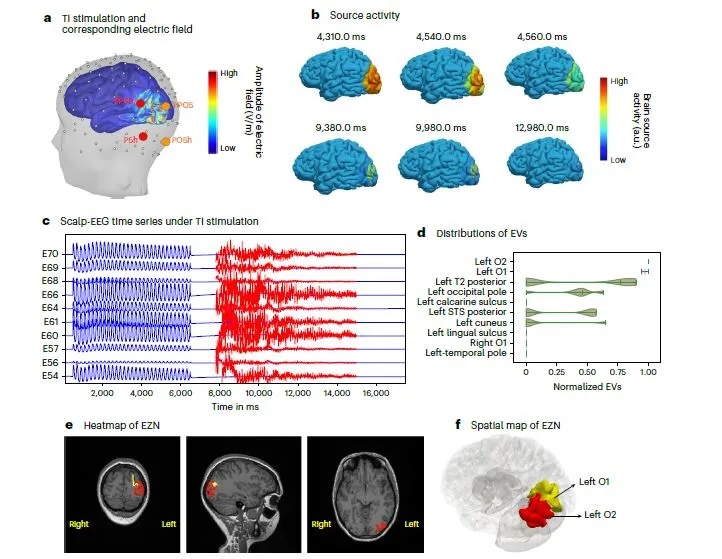Virtual Brain Twins: A new approach in epilepsy diagnosis and treatment

Workflow of VBT for estimating EZN - stimulation techniques (epilepsy)
High-resolution personalised digital brain models simulate stimulated seizure activity and pave the way for non-invasive personalised treatment alternative to surgery for patients affected by drug-resistant epilepsy.
A new diagnostic and treatment paradigm
A new study published in Nature Computational Science, titled Virtual Brain Twins for Stimulation in Epilepsy introduces an innovative method that could change how clinicians diagnose and treat drug-resistant focal epilepsy.
Researchers tested the predictive power of the personalized virtual model (whole-brain models) for different electrical stimulation techniques used to induce seizures to diagnose and treat epilepsy. These included invasive (e.g., stereo electroencephalography, SEEG) and non-invasive methods (e.g., temporal interference, TI), and even the simultaneous and combined use of two modalities of functional recordings (SEEG and scalp EEG).
A new method to identify the epileptogenic zone network (EZN)
A personalised whole-brain model workflow, called virtual brain twins, was first created by combining patients' anatomical data from magnetic resonance imaging (MRI scans) with functional recordings such as electroencephalography (EEG) and stereo-EEG (SEEG), to deliver better predictions. This approach employs the Epileptor model to reproduce how seizures start and spread in each patient. Beyond epilepsy, Virtual Brain Twins are now being explored as tools for studying other brain disorders.
In this study researchers go a step further and present for the first time the development of a promising new technique: a high-resolution personalised “virtual brain twin” workflow designed to improve the identification of patient’s epileptogenic zone network (EZN), the brain area responsible for generating seizures. To do this, they applied stimulation-induced seizures - provoked both via SEEG and temporal interference (TI) methods - to the virtual brain twin.
The novel high-resolution feature was essential since only high-resolution VBTs allow to track electric fields and precisely display them in the 3D Mesh heatmap of the brain.
Virtual brain twins for Stimulation for SEEG stimulation
Accurate diagnosis is essential for patients with epilepsy. In the last 15 years, in complex cases, SEEG, an invasive brain procedure involving the implantation of SEEG electrodes deep into the brain, has become one of the main clinical methods to identify the EZN.
While SEEG stimulation is already applied routinely in clinical practice for this diagnosis, the present study introduces, for the first time, the use of stimulation within Virtual Brain Twins (VBT) as a promising new non-invasive approach.
The virtual brain twins workflow for SEEG-stimulation was built based on the anatomical and functional information and data of a right-handed 23-year-old female patient with left occipital lobe epilepsy. Then researchers proposed high-resolution virtual brain twins for SEEG and TI stimulation.
Starting with SEEG simulation, they triggered direct artificial electrical stimulation inducing seizures on the virtual brain. Then they calculated patient-specific parameters from the synthetic SEEG and EEG signals to better predict epileptic activity in the real brain. In practice, they employed an advanced algorithm to sample more efficiently complex posterior probability distributions of key parameters, allowing them to estimate real epileptic activity in relation to different brain areas.
The application of this algorithm allowed researchers to pinpoint the location and dynamics of the EZN on the 3D brain map. This resulted especially valuable when spontaneous seizures are not recorded during SEEG implanted periods.
Virtual brain twins for Temporal Interference (TI) stimulation
Researchers have recently explored whether the same insights on seizure zones mapping could be achieved using non-invasive and safer alternatives to SEEG, such as scalp EEG (electrodes applied outside the brain) recording during temporal interference (TI) stimulation. TI stimulation is an emerging technology that channels high-frequency electrical currents through the scalp targeted to reach deep brain structures, without surgery.
In the study, seizure dynamics were also simulated on the virtual brain of the patient, by applying the TI stimulation inputs. Then researchers extracted the data features from the resulting synthetic digital scalp-EEG recordings to identify the brain area where the EZN was located.
Early studies have also demonstrated the safety of TI stimulation in humans, though this theoretical pipeline needs further testing and review before being applied in clinical settings.

Process to estimate EZN from TI-stimulation-induced seizure
Simultaneous multiple modality
Another finding presented in the study consists in the possibility to integrate simultaneous multiple modalities of brain recordings (e.g. SEEG and scalp-EEG case) into the model inversion algorithm. This allows to combine their information to estimate the EZN, suggesting this approach could improve clinical decision-making.
Beyond epilepsy: a platform for broader brain disorders
A major innovation in the study is the use of the virtual brain twins workflow, to simulate seizures triggered by electrical stimulation - whether through SEEG or non-invasive TI. These stimulation-induced seizures proved to be a reliable diagnostic tool, even when spontaneous epileptic episodes were not captured in the patient.
Besides, the virtual brain twin concept in stimulation shows potential for broader applications and has already been extended to other brain disorders, including Alzheimer’s disease, Parkinson’s disease and Schizophrenia.
Towards a New Standard in Neurodiagnostics
The innovative pipeline presented in this study includes several key advancements:
- the creation of a personalized high-resolution virtual brain models for either SEEG or TI stimulation;
- the ability to identify the EZN using stimulation-induced seizures, validated by simulated data;
- the integration of multiple simultaneous data sources to refine the localisation of the EZN;
- the adaptability to different brain atlases, regional connectivity differences, and different patient profiles.
In summary, this study presents a workflow for estimating the EZN using a personalized high-resolution virtual brain twin under a stimulation paradigm. This workflow could make it easier to personalise diagnosis and guide more effective treatment and intervention.
Find the full open access paper
Wang, H.E., Dollomaja, B., Triebkorn, P. et al. Virtual brain twins for stimulation in epilepsy. Nat Comput Sci 5, 754–768 (2025). https://doi.org/10.1038/s43588-025-00841-6